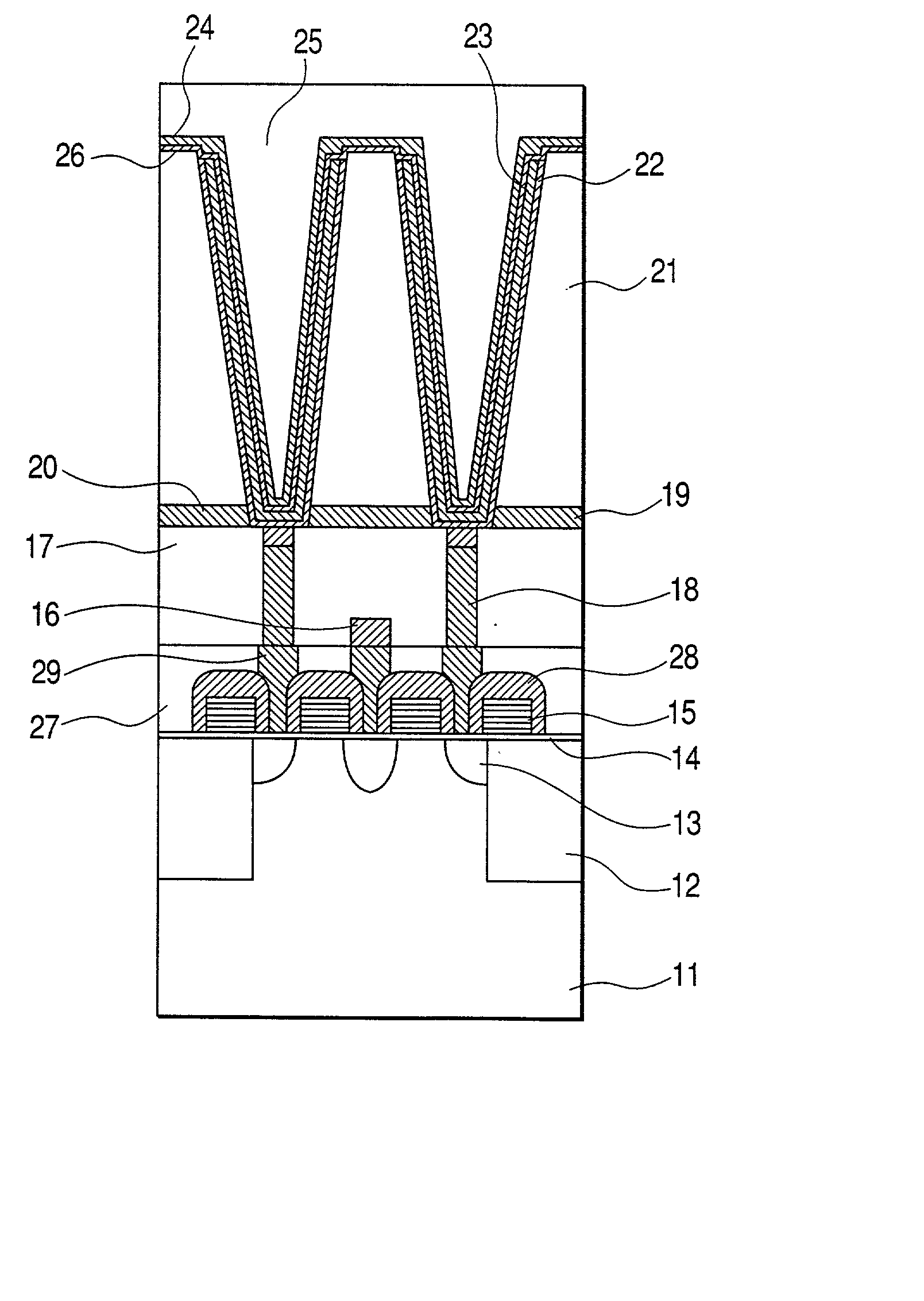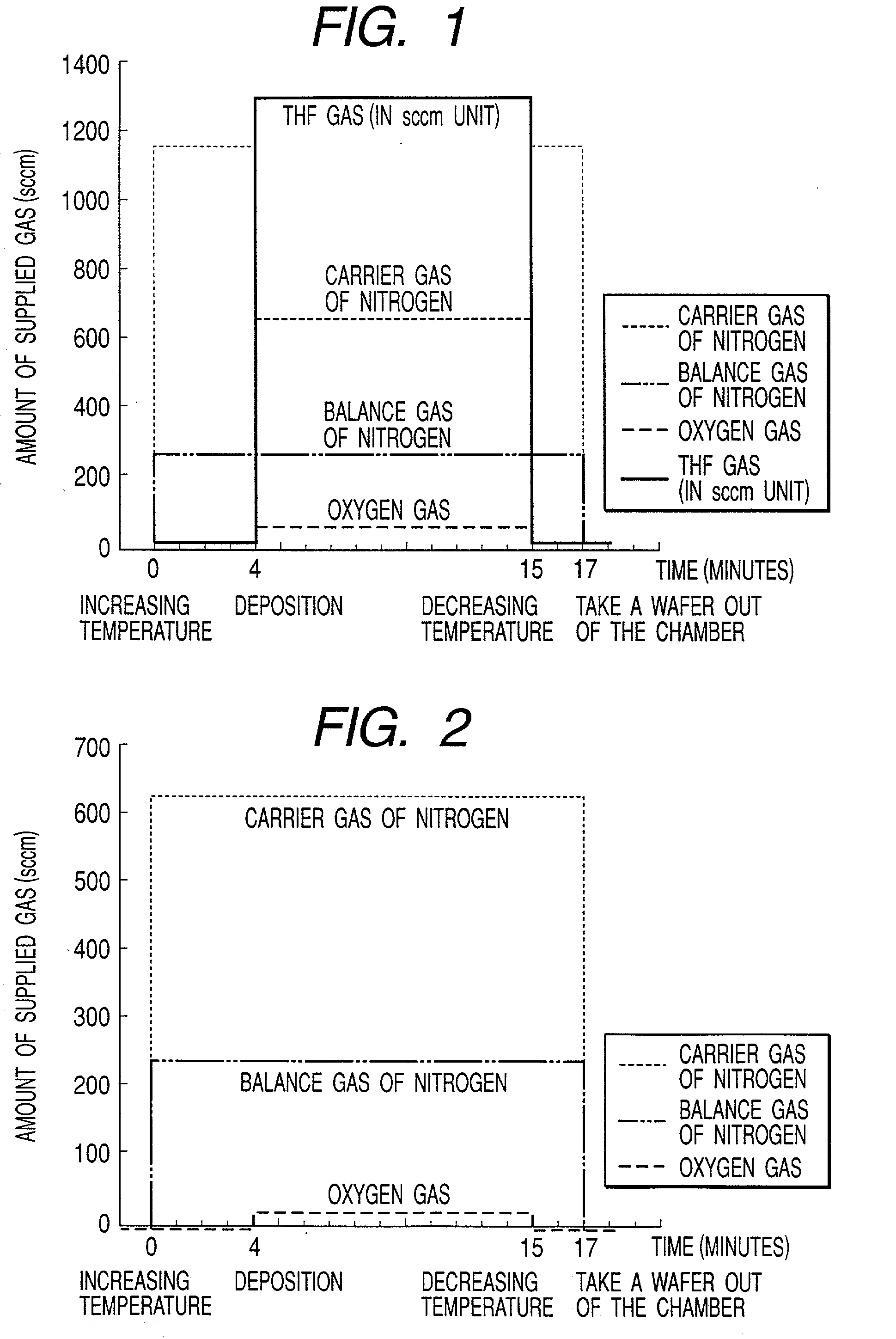Fabricating method of semiconductor integrated circuits
a technology of integrated circuits and fabrication methods, which is applied in the direction of semiconductor/solid-state device details, coatings, transistors, etc., can solve the problems of ruthenium film peeling, capacitors being poorly insulated, and not well conducted
- Summary
- Abstract
- Description
- Claims
- Application Information
AI Technical Summary
Problems solved by technology
Method used
Image
Examples
embodiment 2
[0060] In this embodiment, a precursor gas, an oxidation gas, and an inert gas are introduced to form a bottom electrode of ruthenium. FIG. 7 shows the configuration of an apparatus. The case where a liquid precursor Ru(C.sub.5H.sub.4C.sub.2H.sub.5).sub.2 is loaded in a precursor container is taken as an example. Ru(C.sub.5H.sub.4C.sub.2H.sub.5).sub.2 is heated and vaporized by a vaporizer held at 150.degree. C., and carried by using a nitrogen gas as a carrier gas into a mixer. The flow rate is controlled by a mass flow controller (MFC). Then, the mixed gas is mixed with an oxygen gas, which is a reaction gas, before entering a deposition chamber. The precursor, oxygen gas, and the carrier gas of nitrogen are supplied through a distributor (shower-head) onto a wafer heated by a heater. The partial pressure of each gas in the deposition chamber is adjusted by making constant the flow rate of a balance gas of nitrogen supplied through another line and the total pressure in the deposi...
embodiment 3
[0064] In this embodiment, a diluted precursor, a precursor gas, an oxidation gas, and an inert gas are introduce to form a top electrode of ruthenium. A diluted precursor of Ru(C.sub.5H.sub.4C.sub.2H.sub.5).sub.2 dissolved in a THF solvent with a concentration of 0.1 mol / l is used as a precursor. The apparatus configuration is the same as applied in Embodiment 1. When the top electrode of ruthenium is formed, an oxygen gas has to be supplied at both the times when increasing and decreasing the temperature of the wafer in order to inhibit an increase in the leakage current due to the reduction of the high-k dielectric film, such as a tantalum pentoxide film. The gas introduction process for forming the top electrode of ruthenium is as shown in FIG. 3(a).
[0065] A wafer is carried into the vacuum deposition chamber, and then the wafer temperature is increased up to 290.degree. C. over 4 minutes by a heater. At this step, the carrier gas of nitrogen and the balance gas of nitrogen are ...
embodiment 4
[0072] In this embodiment, a precursor gas, an oxidation gas, and an inert gas are introduced to form a top electrode of ruthenium. The apparatus configuration and the vaporization method of the precursor are shown in Embodiment 2. For example, if a liquid precursor Ru(C.sub.5H.sub.4C.sub.2-H.sub.5).sub.2 is loaded in a precursor container to form the top electrode of ruthenium, an oxygen gas has to be supplied at both the times when increasing and decreasing the temperature of the wafer in order to inhibit an increase in the leakage current due to the reduction of the high-k dielectric film, such as a tantalum pentoxide film. The gas introduction process is as shown in FIG. 4(a).
[0073] A wafer is carried into the vacuum deposition chamber, and then the wafer temperature is increased up to 250.degree. C. over 4 minutes by a heater. At this step, the carrier gas of nitrogen and the balance gas of nitrogen are supplied at rates of 600 sccm and 250 sccm, respectively. Further, an oxyge...
PUM
| Property | Measurement | Unit |
|---|---|---|
| Grain size | aaaaa | aaaaa |
| Grain size | aaaaa | aaaaa |
| Partial pressure | aaaaa | aaaaa |
Abstract
Description
Claims
Application Information
 Login to View More
Login to View More - R&D
- Intellectual Property
- Life Sciences
- Materials
- Tech Scout
- Unparalleled Data Quality
- Higher Quality Content
- 60% Fewer Hallucinations
Browse by: Latest US Patents, China's latest patents, Technical Efficacy Thesaurus, Application Domain, Technology Topic, Popular Technical Reports.
© 2025 PatSnap. All rights reserved.Legal|Privacy policy|Modern Slavery Act Transparency Statement|Sitemap|About US| Contact US: help@patsnap.com



